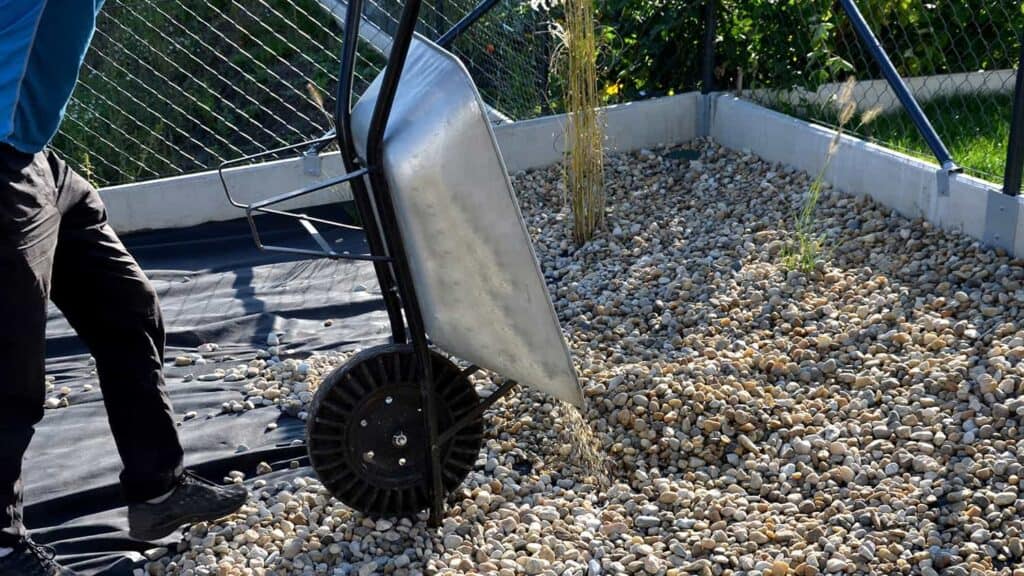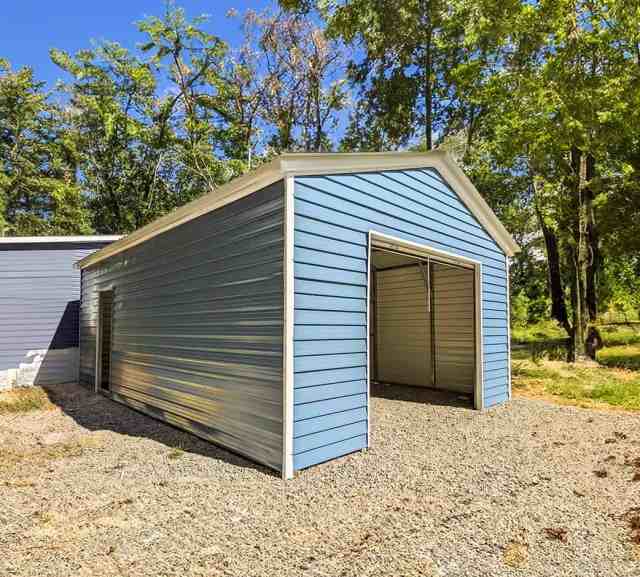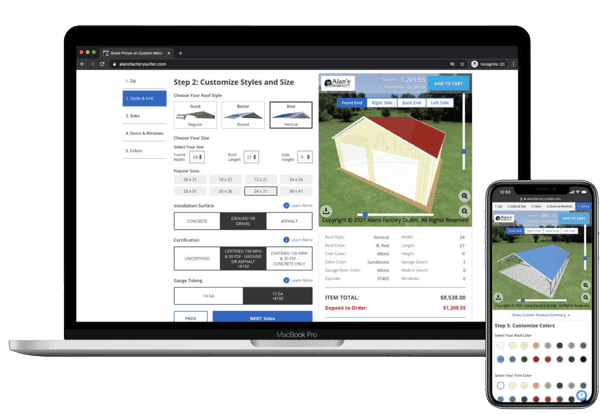Every quality storage shed needs a solid and supportive foundation. Yet, with so many options for a shed foundation, how can you be sure what type of foundation is the right choice? Read on to find out why gravel foundation for a shed is almost always the best option.
Why Is Gravel the Best Foundation for a Shed?
Occasionally, our customers ask, “Isn’t concrete a better foundation than gravel for a shed?” If you were buying a garage to store a vehicle, you would almost certainly want to install it on a concrete pad. However, since most owners use their storage shed for lightweight items, such as store mowers and garden supplies, gravel is just as durable and easier to install in this case.
Eco-friendly and readily available, gravel is the most common foundation for sheds, garages, and other residential structures. But other perks to using this type of material include:
- Cost-effective: One reason that gravel is better for a shed is its affordability. You can expect to pay $1–$3 per square foot for a gravel pad. A concrete slab, on the other hand, starts at $3 per square foot and is a bit expensive.
- Good drainage: A gravel foundation also protects your shed from water damage. While water sits on top of concrete, gravel will let water drain right through the foundation, helping protect your building.
- Less susceptible to settling: Unlike concrete, gravel can adjust to minor shifts in the ground without cracking. This makes it easier for a DIY installation, where you can move and relocate sheds as needed.
- Provides a level surface: When properly installed, a gravel pad can create a stable and even surface for your shed.
- Curb appeal: When framed with timber around the base, gravel stays inside and adds a clean, polished look to gardens and yards.
How To Install a Gravel Foundation for Your Storage Shed
Before you buy a shed, it’s best to have your gravel pad fully installed and ready. That way, delivery and installation of your shed can be quick and hassle-free. Follow along to learn step by step how to install your gravel shed foundation.
Step 1. Gather Necessary Materials
It’s important to gather all of the building materials you’ll need before starting your project. Make sure you have the following items:
| Materials | Tools & Equipment |
| • Protective eye gear • Shovel • Rake • Wheelbarrow • Tamper • Level • Marking chalk/paint • Circular saw • Screw gun • Drill • Sledgehammer | • 6″x6″ lumber (pressure-treated) • 4″ screws • Landscaping fabric • Crushed stone gravel (or gravel of choice) |
Step 2. Prep the Site and Dimensions
Find a site on your property with good drainage to help prevent flooding but not too sloped so that it’s easy to level. You’ll also want the site to be clear of utility lines.
Next, mark the corners of your foundation, making sure your gravel pad is at least two inches longer and wider than your shed.You should use a bubble string level or a transit level to check the foundation. Use a tamper to make sure it is even from front to back, side to side, and corner to corner.
Step 3. Excavate
Remove a few inches of soil to create a space for the gravel base. If you prefer not to do any digging, you could use 6″x6″ wooden beams to build a frame around the perimeter of the shed foundation before you put 6″ of gravel down.
Step 4. Build the Perimeter
Add the first layer of your 6”x6” lumber along the marked perimeter of your site foundation, checking each to ensure their level. Secure each with 4” screws. Repeat this step for your next layer of lumber, overlapping the corners of each piece.
Step 5. Install Landscaping Fabric
Lay down landscaping “construction” fabric to create a weed barrier and allow for drainage. It also provides an additional level of stability for the foundation.
Step 6. Lay and Compact the Gravel
Using the wheelbarrow (or truck if for a larger site), pour your choice of gravel as evenly as possible throughout the area. Use a rake to help spread out and level the gravel. Finally, thoroughly tamp the gravel to secure it in place and create a stable base.

Now, you’re ready to install your shed! Since the gravel is compact, you can place it directly on top with no problem.
Additional Considerations When Using a Shed Foundation
While we recommend gravel for your shed base, there are still a few factors to consider before using it:
- Shed size and weight: Gravel foundations are best suited for smaller storage sheds. Concrete provides more support for larger and heavier storage items, such as vehicles.
- Local building codes: It’s important to check with your local building department first to ensure a gravel foundation is compliant. This may be the case for larger storage sheds and metal buildings.
- Weed control: Consider using landscaping fabric underneath the gravel to prevent weeds from growing through. The fabric will serve as a barrier and help maintain the level.
What Type of Gravel Is the Best for My Shed Foundation?
We recommend 3/4″ stone, which is also called 57 Granite. Another option is “crusher run,” which is a mix of 3/4″ stone and smaller stones.

The type of gravel you should use depends partly on whether or not your shed will be located in a wet area. If the ground has moisture, you should consider using 3/4″ bluestone as it will provide additional drainage benefits over the crusher run.
If your shed will be resting in a dry location, the crusher run will work fine. One advantage of the crusher run is that it tends to become really compact after a while, creating a “concrete look,” so to speak. In most cases, it’s also more affordable. However, if moisture isn’t a factor, the type of gravel comes down to your personal preference.
Frequently Asked Questions
How big should my shed foundation be?
We recommend making the gravel base 2’ wider and 2’ longer than the size of the shed. That way, you’ll have an extra foot of space on both sides and ends to help prevent dirt from splashing up on the sidewalls of the shed.
How much gravel do I need for my shed foundation?
You’ll want to have a 4” to 6 “ gravel base. For better drainage and protection for your shed, go with the 6” deep gravel pad.
Does the shed foundation need to be level?
Yes. Leveling is the most important yet overlooked factor when it comes to shed foundation planning. Many people will just look the gravel foundation over with their eyes and assume it’s level without checking it with a tool.
Do I really need a foundation for a shed? Can I put it on blocks instead?
We don’t recommend putting your storage shed on blocks. Using blocks can lead to settling issues in the future. They also don’t provide support for the full length of the structure. A gravel foundation is a much better option than blocks.
If you are ordering a metal shed from Alan’s Factory Outlet, we can’t install it on blocks. Here are some of your options:
• Level gravel pad
• Concrete or asphalt pad
• On the ground
Please keep in mind some states and counties may require a concrete pad with footers, so it’s good to check with your local building department.
Customizable Storage Sheds for Gravel Pads
Just like a house or a garage, the most important thing for a storage shed is to make sure it has a strong foundation.
Here at Alan’s Factory Outlet, we’ve helped thousands of customers get custom metal sheds delivered and installed on their property. From experience, we’ve learned that a gravel foundation is almost always the best option for a shed.
Use our 3D Builder to design your own custom shed and get instant pricing. No email required.




